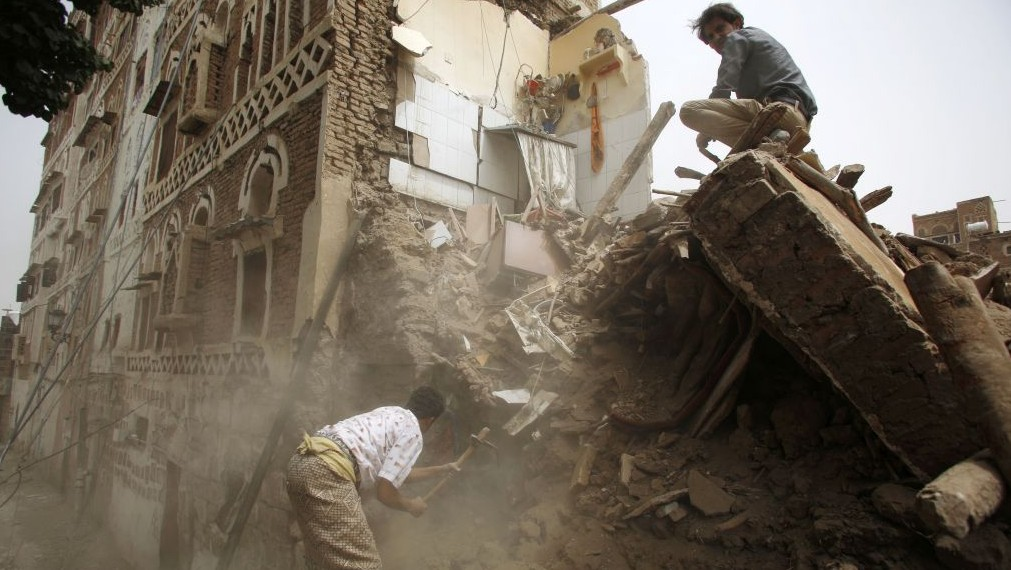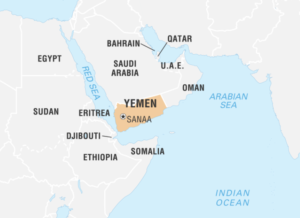
Five years of war have ravaged the architectural heritage of Yemen, destroyed water systems, closed ports to aid, disrupted domestic agriculture and left nearly half the country malnourished
Journalists describe the conflict in Yemen as a sectarian proxy war between Saudi Arabia and Iran, but that fails to capture the complexity of the war: in October, 2020, Human Rights Watch reported more than thirty battle fronts between various armed groups. The Biden administration has signaled changes in US policy, but a solution to the humanitarian disaster remains elusive.
The war’s origins lie in the former Yemeni government’s neglect of the Zaydi-dominated north, its suppression of Zaydi schools and religious teachings, and the free rein it gave to Saudi proselytizers. In response the Ansar Allah (“Houthi”) militia formed in the 1990s, leading uprisings that were brutally suppressed by Yemeni President Ali Abdullah Saleh (ruled 1978–2012). Saleh claimed that the Shi’ite Houthis were Iranian-backed, but Zaydi Shi‘ism is very different from the Twelver Shi‘ism of Iran, and Zaydis do not identify with Iran.
Yemen’s “Arab Spring” uprising forced Saleh from power in 2012, and Vice President Abdrabbuh Hadi became president. The Houthis were shut out of the National Dialogue Conference of 2013–14 that formulated plans to balance Yemen’s multiple political factions, leading them to ally with the ousted president in September, 2014 and advance militarily on the capital, Sanaa. Hadi dissolved parliament and fled to Saudi Arabia, abandoning Sanaa to the Houthis, who proceeded to subdue much of the country. They encountered resistance from remnants of the national army, from southern separatist forces (Yemen’s north and south united only in 1990), and from Al-Qaeda in the southeast. They captured the former South Yemen capital, Aden, in March, 2015. In about 2015 Iran began offering the Houthis moral support and limited military training, but they are hardly a proxy force.

Yemen is a country of 26 million located strategically at the entry to the Red Sea and the Suez Canal
The Saudis, already threatened by a strong Iranian presence in Iraq and Syria, could not abide Shi‘ite domination to the south. They attempted to undermine the Houthis by imposing a blockade of oil, food and other necessities, and withholding their previously substantial aid. In March, 2015 they formed a coalition with the United Arab Emirates (UAE), Qatar, Bahrain, Kuwait, Egypt, Jordan, Morocco, and Sudan, and began an intensive bombing campaign that devastated parts of Sanaa. The Obama administration agreed to provide arms and logistical support to the Saudis to placate them for the Iran nuclear deal, but expectations for a quick victory over the Houthis went unfulfilled. The Saudi-allied UAE led an amphibious attack on Aden in July, 2015, but despite declaring control over the port, were unable to prevent its descent into multi-sided violence.
In May, 2017, the Saudis intercepted the first ballistic missile the Houthis fired toward the Saudi capital, Riyadh, marking a new expansion of the war. When former President Saleh accused his Houthi allies of recklessness, they assassinated him. In 2018 fighting broke out between allies on the other side; although the UN recognized Hadi’s Saudi-backed forces, the UAE-backed Southern Transitional Council (STC) continued to claim control over the south. The UAE withdrew most of its troops from Yemen in June, 2019 (anticipating a possible US-Iran military confrontation); but in signing a security agreement with Iran and meeting with Houthi leaders, it worsened Saudi-UAE relations. Rivalry worsened when STC fighters seized the island of Socotra in June, 2020 and raised the flag of the former Communist state of South Yemen. Most recently, in June, 2021, militia leader Tariq Saleh acknowledged that his UAE-backed troops are stationed on Perim Island off the coast of Yemen in the crucial maritime chokepoint of Bab al-Mandeb, where a mysterious air base is under construction. The Saudi-affiliated Hadi government demanded a formal investigation into the base.

Both the UAE and the Saudis have hired mercenaries, including soldiers from Sudan and the United States
The humanitarian cost has been staggering. Almost a third of Saudi coalition airstrikes hit homes, hospitals, schools, farms, food stores, and water wells. Bombardment of the Houthi-held port of Hodeidah, through which 75 percent of international relief passes, exacerbated suffering. The Houthis also hampered aid. They spread disinformation about COVID-19 and obstructed vaccine distribution. They have impeded UN efforts to access a stranded oil tanker that threatens to spill 1.14 million barrels of crude oil into the Red Sea, four times the amount the Exxon Valdez leaked in 1989.
In 2019 the UN warned that 14 million people—half of Yemen’s population—could soon be on the brink of starvation, 24 million were in immediate need of humanitarian assistance, and at least 3.3 million were internally displaced. The collapse of the economy made the scarce food unaffordable to most. Civil servants went unpaid; garbage piled up; diptheria, measles and dengue fever raged; and cholera struck two million between 2016 and 2019. More than half of Yemen’s health facilities closed as abductions, detentions, and threats prompted health workers to flee. All parties to the conflict are suspected of using starvation as a weapon of war.
Growing criticism of Saudi airstrikes in Yemen led the US Congress to block a planned arms sale in 2017 and call for an end to support for the Saudi-led war in 2019. In February, 2020, the Biden administration finally announced the end of US support for Saudi operations in Yemen, though it remains uncertain how US arms sales intended for Saudi defense will be differentiated from those intended for the war in Yemen. Biden also appointed a special envoy to Yemen, signaling a more active US role in peace efforts, and reversed the Trump administration’s designation of the Houthis as a foreign terrorist organization, a designation which aid organizations had deemed counterproductive to humanitarian assistance efforts. However, when the Houthis launched a March offensive against the gas-rich, Hadi-held province of Marib, leading to new civilian casualties and massive population displacement, the US imposed sanctions on two Houthi leaders and an Iran-based network that funnels aid to the Houthis. To the dismay of rights advocates, in April the State Department indicated it would proceed with a $23.4 billion Trump-initiated transfer of sophisticated weaponry to the UAE.
After six years of inconclusive war, Saudi Arabia is seeking an exit strategy. The Houthis are less interested; they refused to meet with UN and US envoys in Oman early last month, although they did hold indirect talks through mediators. In an unprecedented shift, the US envoy recently referred to the Houthis as “legitimate” actors in the conflict and noted “elements within the leadership” that favor peace. The Saudis immediately protested the remark, and the US hastened to clarify its recognition of Hadi’s government as the only legitimate power in Yemen. Houthi spokesman Nasrullah Amer dismissed the US overture: “We are not waiting for anyone to recognize our legitimacy as much as a change in behavior by the United States toward our country as a whole.” The Houthis demand an end to the blockade imposed by US naval vessels and to the ban on flights through the rebel-held international airport. Amer reminded listeners that it was in Washington that the Saudis announced their war against the Houthis in 2015; and from the Houthis’ perspective, only Washington can end it.
It is clear that, far from being a simple Sunni-Shi‘ite conflict, the war in Yemen is fought by multiple domestic rivals and their external patrons. US and UN peacemaking efforts have failed in part because they continue to see the complicated war through an inadequate two-sided framework.

Valerie Hoffman is Professor of Islamic studies in the Department of Religion at the University of Illinois at Urbana-Champaign.
829 total views, 1 views today
